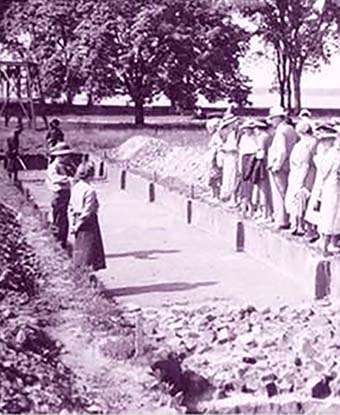Last updated: July 16, 2024
Person
J.C. and Virginia Harrington

NPS photo.
Jean Carl Harrington, often called “J.C.” or Pinky, and Virginia Sutton Harrington were two pioneering National Park Service archeologists. The couple met while graduate students at the University of Chicago studying anthropology and archeology, and married in 1938 while working at Jamestown. Together, Virginia and J.C. excavated and interpreted many important historic archeological sites throughout the United States, and helped to form the discipline of historical archeology.
J.C. Harrington was born in 1901 in Michigan. He completed a degree in architectural engineering at the University of Michigan in 1924, then pursued a career in architecture until the onset of the Great Depression. After a summer spent in New Mexico during his undergraduate studies, Harrington first became interested in archeology. J.C. decided to pursue a graduate degree in archeology at the University of Chicago. He finished his Master’s degree in 1935 and passed his comprehensive exams the year after.
In 1936 the National Park Service offered Harrington a job by to excavate the historic Jamestown site. As someone with both archeological and architectural experience, he was perfectly suited to work at the site and mediate conflict between the Jamestown architects and archeologists. Although he was at first hesitant, Harrington accepted the job, and began his 30-year long career with the National Park Service. After work at Jamestown ended as a result of World War II, Harrington was made Superintendent of Colonial National Historical Park. He held this position until 1954 when he was made the Eastern Regional Archeologist for the Southeast Region of the National Park Service, a position he held until his retirement in 1965.
Although he began his career working at Native American sites before European contact, J.C. is best remembered as one of the pioneers of historical archeology, the study of archeological sites for which there is recorded history. J.C. arrived at Jamestown in 1936 with no experience in historical archeology, a field then still in its infancy. Harrington became one of the biggest advocates for historical archeology. One important contribution is a system of dating using the stem width of clay tobacco pipes, which is still used today (“Dating Stem Fragments of Seventeenth and Eighteenth Century Clay Tobacco Pipes”). In honor of his accomplishments, the Society of Historical Archaeology created the J.C. Harrington Award. He was also awarded a Citation for Distinguished Service from the United States Secretary of the Interior in 1952, a high honor.
Virginia Sutton was born and raised in Washington D.C., and attended Swarthmore College, where she received a Bachelor’s degree in history in 1934. That same year she joined the National Park Service as a seasonal Ranger Archeologist at Mesa Verde. Like J.C., Virginia undertook graduate studies at the University of Chicago, where she completed a Master’s degree in anthropology. In 1937 she took a job at Jamestown as the site’s Ranger Historian- the very first woman to hold the position of Ranger Historian in the National Park Service. While at Jamestown, she worked with J.C. to excavate the site, but also provided interpretation for visitors. Her efforts to engage the public included exhibits at the Jamestown Education Museum and a program called “This Week at the Excavations,” which gave weekly exhibits and tours about the work completed that week and lab for public viewing (“A New Archaeology in the New Deal: The Rise of Historical Archaeology in the 1930’s”, 39). While at Jamestown, she passed the junior archeologist examination and was made a permanent archeologist at Colonial National Historical Park.
Alone, J.C. and Virginia Harrington were important archeologists. Together, they worked as a team to excavate important archeological sites, establish professional associations, travel across the world, and even continue to excavate after retirement. In addition to their work at Jamestown, J.C. and Virginia collaborated at many of the projects J.C. directed for the NPS including Fort Raleigh and Fort Necessity. The couple also helped to establish the Eastern National Park and Monument Association, which supported the work of NPS archeologists and historians and made their research available to the public. Virginia served as the first treasurer of the group. After J.C. retired from the National Park Service in 1965 the couple conducted excavations in Nauvoo, Illinois and on Constitution Island for West Point Military Academy. It is without a doubt that both the archeology of the National Parks and the field of American archeology are greatly indebted to the work of J.C. and Virginia Harrington.
